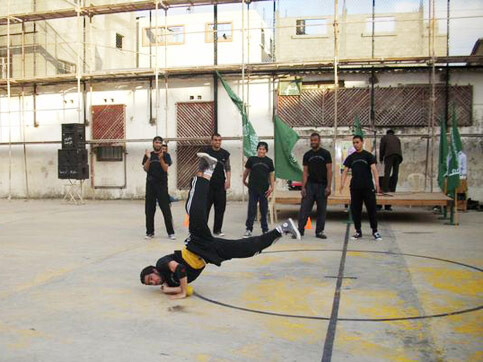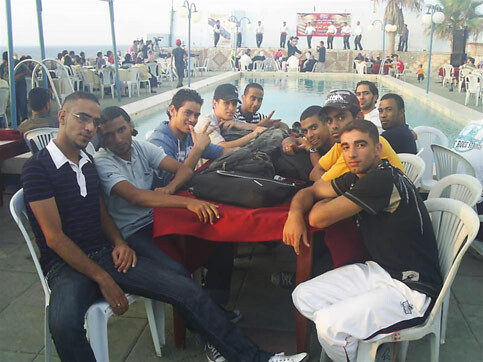The Electronic Intifada 13 July 2009

The Camp Breakerz performing in the Gaza Strip. (Camp Breakerz)
It was a summer Wednesday evening and Muhammad al-Ghreiz, 22, was getting his eight-member team ready for a breakdance show at the al-Baydar restaurant on the beachfront just south of Gaza City. Six months ago, Gaza’s beaches were under heavy Israeli bombardment from air and sea, but now this area, near the evacuated Israeli settlement of Netzarim, was about to hear an altogether different kind of sound.
Breakdance, the hip hop dance style that began on the streets of New York City more than 30 years ago has become popular with youth all over the world, even breaking through the tight Israeli blockade imposed on the Gaza Strip.
The audience began to flow in to the restaurant and a band played some classical Arabic music while cheerful children ran around the swimming pool.
After a number of other acts, the evening’s MC surprised the audience by announcing that the next performers would be breakdancers from the Nuseirat refugee camp and surrounding areas.
Al-Ghreiz and the other b-boys leapt on to the stage wearing black T-shirts emblazoned with the words “Camp Breakerz” — the name of their group. Their moves caused excitement among the audience — many went right up to the stage, and others took pictures with their mobile phones of an exuberant scene.
At one point in the 10-minute set, the group formed a circle, as one of their members danced in the middle. Afterwards, al-Ghreiz explained that the circle symbolized the siege on Gaza. “Our teammate in the middle stood for the children [of Gaza],” al-Ghreiz told EI. “As you saw, the circle was broken by our fellow dancer, indicating the Palestinian child’s strong determination to live normally as other children around the world.”
Camp Breakerz was established in 2005 by Muhammad al-Ghreiz and another friend from the Nuseirat refugee camp, Ahmed Ismail. Both are recent graduates from nursing school. Ismail is currently a temporary assistant nurse at the al-Shifa hospital of Gaza, while al-Ghreiz is on the waiting list for a position.
In 2004, al-Ghreiz and his family returned to Gaza from Saudi Arabia where they had been living. “I used to breakdance in Saudi Arabia,” al-Ghreiz said. “In 2005 I got to know Ahmad, who had also returned from Saudi Arabia, and we began training in my house in the Nuseirat refugee camp.” Eventually others joined them and they grew into Camp Breakerz.

The Camp Breakerz pose for a photograph after their performance at the al-Baydar restaurant in Gaza City. (Rami Almeghari)
Ismail recalled some of the difficulties he and al-Ghreiz faced when they first began, especially reactions from people around them. “As you know, this is a conservative, Muslim society,” Ismail said, but gradually people began to support what they were doing. “We began to convince them that what we do is part of a sport, and a nice art that can deliver a message.”
There were other challenges as well. Ismail suffered from pain in his pelvis that made it difficult to continue dancing, but he stayed with the team, supporting them in other ways. The group has never been able to afford an office, or had a permanent place to train.
Until January Camp Breakerz often trained at the al-Ahli sports club in the Nuseirat refugee camp. “Unfortunately, the entire club was completely destroyed during the last war and we are now on our own,” Ismail said, in reference to the 22-day Israeli attack which destroyed thousands of private homes, public buildings and facilities and killed more than 1,400 people. Now they are back to training at al-Ghreiz’s house in the camp.
The team members — who range in age between 15 and 25 — contribute some of their own money, according to Ismail. Appeals to local non-governmental organizations (NGOs) and charities for support have proved fruitless even though the break-dancers perform at the invitation of many such groups.
Ahmad Ismail stresses that Gaza’s b-boys are are developing their own original style: “The most important part of what we do is education … Our main message is to reflect our own unique Palestinian situation. We educate our team members not to be blind imitators of western-style dancing.”
“Puma” is the nickname of Fahed Abdulrahman, one of the oldest team members, who had long been interested in joining the group. “I am from Bedouin Palestinian folk,” he told EI, “however my family had no objection to breakdance. They encouraged me, as I and my fellow dancers are growing.” Abdelrahman hopes the group will continue to expand, adding, “We have no limited ambitions, every day we have news ideas.”
Ahmad al-Hourani, 16, said that when he began break-dancing his cousins told him, “this is disco [a term generally used to describe western-style dancing], and that is against our Palestinian traditions.” But they too came around, recognizing it as a skilled and worthwhile activity. “I dream of becoming a great breakdancer,” al-Hourani said, “when I dance, I feel I have achieved something.”
The breakdancers have performed all over the Gaza Strip in the past four years. Many shows were at special ceremonies, such as Mother’s Day, the inauguration of an amusement park or a zoo, or at community-based organizations.
As the show at al-Baydar restaurant ended, and the audience left, some pointed at the crew in the black T-shirts, and others uttered words of amazement or appreciation. Muhammad al-Ghreiz reflected on what his group’s work means: “The Palestinian people are still alive and that we have an art form that can send out a message of peace to our brothers and sisters around the globe.”
Rami Almeghari is a journalist and university lecturer based in the Gaza Strip.
Related Links





